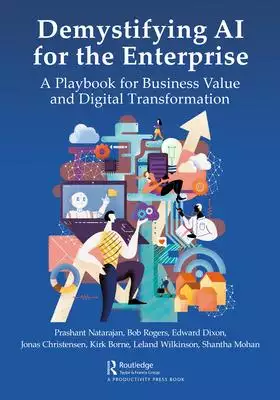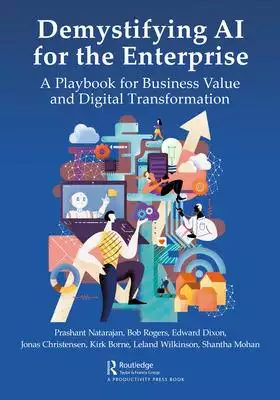installation has fai的問題,透過圖書和論文來找解法和答案更準確安心。 我們找到下列懶人包和總整理
installation has fai的問題,我們搜遍了碩博士論文和台灣出版的書籍,推薦Natarajan, Prashant,Rogers, Bob,Dixon, Edward寫的 Demystifying AI for the Enterprise: A Playbook for Business Value and Digital Transformation 和Natarajan, Prashant,Rogers, Bob,Dixon, Edward的 Demystifying AI for the Enterprise: A Playbook for Business Value and Digital Transformation都 可以從中找到所需的評價。
這兩本書分別來自 和所出版 。
國立中山大學 電機工程學系研究所 林吉聰所指導 黃世欽的 雙面三端點CIGS太陽能電池 (2018),提出installation has fai關鍵因素是什麼,來自於銅銦鎵硒、三端點、雙面照光、能量增益、雙面因子。
而第二篇論文國立陽明大學 護理學系 雷燕萍所指導 莊鈺如的 探討醫院自製蔬果汁的營養介入改善頭頸癌病人接受同步放射線化學治療營養狀態及生活品質之影響 (2015),提出因為有 頭頸癌病人、放射線化學治療、營養狀態的重點而找出了 installation has fai的解答。
Demystifying AI for the Enterprise: A Playbook for Business Value and Digital Transformation

為了解決installation has fai 的問題,作者Natarajan, Prashant,Rogers, Bob,Dixon, Edward 這樣論述:
Prashant Natarajan is Product Director of Healthcare Solutions at Oracle in the Health Sciences Global Business Unit. He has portfolio responsibility for precision medicine, population health, translational research, and convergence products. He is passionate about helping healthcare organizations m
aximize their technology investments to improve patient care, provider satisfaction, personal wellness, and health policy. Prior to joining Oracle in 2008, Prashant contributed to progressive career roles as product manager, emerging technologies specialist, and consultant at Healthways, McKesson, S
iemens, and eCredit. Com.Prashant received his master’s degree in technical communications and linguistics from Auburn University (2005) and his undergraduate degree in chemical engineering from Mangalore University (1999). He is also a Stanford Certified Project Manager. Prashant is author or contr
ibuting author of three books on healthcare informatics.Prashant is Industry Advisor for Data Science and AI at UCSF/Center for Imaging of Neurodegenerative Disease in the San Francisco VA Center. He volunteers on the Board of Advisors for the Council for Affordable Health Coverage, Washington, DC,
and is currently serving as Co-Chair of HIMSS NorCal’s Innovation Committee.Dez Blanchfield is a strategic in business and digital transformation, with 25 years experience in the information technology and telecommunications industry, developing strategy and implementing business initiatives. His sp
ecialties include; cloud computing, big data and analytics, cognitive computing, machine learning, Internet of Things, digital transformation infrastructure and architecture and security and regulatory compliance.Kirk Borne is the Principal Data Scientist and Executive Advisor at Booz Allen Hamilito
n. He is a data scientist and an astrophysicist who has used his talents at Booz Allen since 2015. He was professor of astrophysics and computational science at George Mason University (GMU) for 12 years. He served as undergraduate advisor for the GMU data science program and graduate advisor in the
computational science and informatics Ph.D. program.Kirk spent nearly 20 years supporting NASA projects, including NASA’s Hubble Space Telescope as data archive project scientist, NASA’s Astronomy Data Center, and NASA’s Space Science Data Operations Office. He has extensive experience in large sci
entific databases and information systems, including expertise in scientific data mining. He was a contributor to the design and development of the new Large Synoptic Survey Telescope, for which he contributed in the areas of science data management, informatics and statistical science research, gal
axies research, and education and public outreach.Bob Rogers, PhD is Chief Data Scientist for Analytics and Artificial Intelligence Solutions at Intel, where he applies his experience solving problems with big data and analytics to help Intel build world-class customer solutions. Prior to joining In
tel, Bob was co-founder and Chief Scientist at Apixio, a big-data analytics company for healthcare. He has co-authored the book Artificial Neural Network: Forecasting Time Series, which led to a twelve-year career managing a quantitative futures trading fund based on computer models he developed. He
received his BS in Physics at UC Berkeley and his PhD in Physics at Harvard.John Frenzel, MD, is the Chief Medical Informatics Officer at MD Anderson Cancer Center and a Professor in the Department of Anesthesiology and Perioperative Medicine. He received his medical degree from Baylor College of M
edicine and completed his fellowship training in Cardiovascular and Thoracic Anesthesia at the Mayo Clinic in Rochester, MN.In 2001, he received a Master’s Degree in Informatics from the University of Texas Health Science Center Houston, School of information Science. Dr. Frenzel has been active in
applied informatics throughout his career at MD Anderson.In addition to several clinical leadership roles, in 2010 he was asked to led the development and installation of MD Anderson’s third-generation Clinical Data Warehouse, which sought to bring together all institutional clinical and genomic dat
a. In 2012, he was asked to help lead the Institution’s effort to install the Epic EHR and integrate clinical data back into the institutional warehouse. John has published on various topics pertaining to clinical informatics. He is currently focused on the use of Time-Driven Activity-Based Costing
(TDABC) to drive hospital revenue process optimization and labor costing efforts in preparation for bundled payments in oncology care. He is Board certified in both Anesthesiology and Informatics.
雙面三端點CIGS太陽能電池
為了解決installation has fai 的問題,作者黃世欽 這樣論述:
在本篇碩士論文中,我們提出了三端點的雙邊銅銦鎵硒(DS-CIGS)太陽能電池,此元件可應用於雙面照光藉此增加元件輸出功率。在此太陽能電池中其元件特色主要由兩個CIGS子電池形成類並聯的架構「SLG / AZO / i-ZnO / CdS / CIGS / ITO / CIGS / CdS / i-ZnO / AZO / Al」,藉由元件背對背共用背電極的方式,並且將此電極使用一層導電氧化銦錫(ITO)作為正電極,在緩衝層的材料選擇上使用硫化鎘(CdS)與吸收層銅銦鎵硒(CIGS)有較好的晶格匹配以及用來降低反射層與吸收層之間的能帶不連續練現象。經由模擬結果顯示,當第三端點透明導電層(ITO)
接受光源時,有過量的光子通過該層時將被另一側的CIGS子電池吸收藉此提升短路電流。我們在參考文獻中探討雙面照光的應用,發現在背部照光時,傳統的CIGS+所獲得的轉換效率非常差,而本碩士論文提出的DS-CIGS新架構也與傳統的CIGS+做比較,分別注重在探討EQE和I-V特性,並且分別比較在背部照光以及正面照光之間的元件特性變化並優化其參數。經由模擬利用傳統架構CIGS+和DS-CIGS在理想的反照率環境下(前後照度相等時)進行測量,我們發現傳統的CIGS+在單面照光與雙面照光做比較時,其轉換效率各為 η monofacial = 20.29 %和 η bifacial = 24.12 % ,顯
示了Energy Boost為18.87 %;而我們的DS-CIGS在單面照光與雙面照光做比較時,其轉換效率各為monofacial = 20.39 %和bifacial = 39.50 %,顯示了Energy Boost為93.17 %。此乃藉由改善背部表面復合進而獲得更多的短路電流,且在前後照光的比較下雙面因子由CIGS+的0.17改進為DS-CIGS的0.89。
Demystifying AI for the Enterprise: A Playbook for Business Value and Digital Transformation

為了解決installation has fai 的問題,作者Natarajan, Prashant,Rogers, Bob,Dixon, Edward 這樣論述:
Prashant Natarajan is Product Director of Healthcare Solutions at Oracle in the Health Sciences Global Business Unit. He has portfolio responsibility for precision medicine, population health, translational research, and convergence products. He is passionate about helping healthcare organizations m
aximize their technology investments to improve patient care, provider satisfaction, personal wellness, and health policy. Prior to joining Oracle in 2008, Prashant contributed to progressive career roles as product manager, emerging technologies specialist, and consultant at Healthways, McKesson, S
iemens, and eCredit. Com.Prashant received his master’s degree in technical communications and linguistics from Auburn University (2005) and his undergraduate degree in chemical engineering from Mangalore University (1999). He is also a Stanford Certified Project Manager. Prashant is author or contr
ibuting author of three books on healthcare informatics.Prashant is Industry Advisor for Data Science and AI at UCSF/Center for Imaging of Neurodegenerative Disease in the San Francisco VA Center. He volunteers on the Board of Advisors for the Council for Affordable Health Coverage, Washington, DC,
and is currently serving as Co-Chair of HIMSS NorCal’s Innovation Committee.Dez Blanchfield is a strategic in business and digital transformation, with 25 years experience in the information technology and telecommunications industry, developing strategy and implementing business initiatives. His sp
ecialties include; cloud computing, big data and analytics, cognitive computing, machine learning, Internet of Things, digital transformation infrastructure and architecture and security and regulatory compliance.Kirk Borne is the Principal Data Scientist and Executive Advisor at Booz Allen Hamilito
n. He is a data scientist and an astrophysicist who has used his talents at Booz Allen since 2015. He was professor of astrophysics and computational science at George Mason University (GMU) for 12 years. He served as undergraduate advisor for the GMU data science program and graduate advisor in the
computational science and informatics Ph.D. program.Kirk spent nearly 20 years supporting NASA projects, including NASA’s Hubble Space Telescope as data archive project scientist, NASA’s Astronomy Data Center, and NASA’s Space Science Data Operations Office. He has extensive experience in large sci
entific databases and information systems, including expertise in scientific data mining. He was a contributor to the design and development of the new Large Synoptic Survey Telescope, for which he contributed in the areas of science data management, informatics and statistical science research, gal
axies research, and education and public outreach.Bob Rogers, PhD is Chief Data Scientist for Analytics and Artificial Intelligence Solutions at Intel, where he applies his experience solving problems with big data and analytics to help Intel build world-class customer solutions. Prior to joining In
tel, Bob was co-founder and Chief Scientist at Apixio, a big-data analytics company for healthcare. He has co-authored the book Artificial Neural Network: Forecasting Time Series, which led to a twelve-year career managing a quantitative futures trading fund based on computer models he developed. He
received his BS in Physics at UC Berkeley and his PhD in Physics at Harvard.John Frenzel, MD, is the Chief Medical Informatics Officer at MD Anderson Cancer Center and a Professor in the Department of Anesthesiology and Perioperative Medicine. He received his medical degree from Baylor College of M
edicine and completed his fellowship training in Cardiovascular and Thoracic Anesthesia at the Mayo Clinic in Rochester, MN.In 2001, he received a Master’s Degree in Informatics from the University of Texas Health Science Center Houston, School of information Science. Dr. Frenzel has been active in
applied informatics throughout his career at MD Anderson.In addition to several clinical leadership roles, in 2010 he was asked to led the development and installation of MD Anderson’s third-generation Clinical Data Warehouse, which sought to bring together all institutional clinical and genomic dat
a. In 2012, he was asked to help lead the Institution’s effort to install the Epic EHR and integrate clinical data back into the institutional warehouse. John has published on various topics pertaining to clinical informatics. He is currently focused on the use of Time-Driven Activity-Based Costing
(TDABC) to drive hospital revenue process optimization and labor costing efforts in preparation for bundled payments in oncology care. He is Board certified in both Anesthesiology and Informatics.
探討醫院自製蔬果汁的營養介入改善頭頸癌病人接受同步放射線化學治療營養狀態及生活品質之影響
為了解決installation has fai 的問題,作者莊鈺如 這樣論述:
癌症所引起的營養不良因素很多,營養不良的病患其預後相對性較差。放射線治療及同步化學放射線治療是頭頸癌病人常見治療方式,然而接受放射線治療造成頭頸癌病人嚴重的口腔粘膜改變、免疫發炎及體重減輕等因素,甚而影響生活品質,最終可能中斷治療而造成生命威脅(Nguyen, Moltz, & Frank, 2006)。國內外研究頭頸癌接受放射線治療之營養狀況、口腔黏膜炎及生活品質很多,以天然蔬果為營養介入措施的研究甚少,故引發本研究之動機。本研究目的包括: (1) 探討蔬果汁營養介入對頭頸部癌症患者接受同步化學放射線治療前、後的營養狀況之影響,(2) 探討蔬果汁營養介入對頭頸部癌症患者接受同步化學放
射線治療期間的免疫發炎及血液生化值影響,(3) 探討蔬果汁營養介入對頭頸部癌症患者接受同步化學放射線治療期間的口腔黏膜炎之影響,(4) 探討蔬果汁營養介入對頭頸部癌症患者接受同步化學放射線治療後的生活品質之影響。 本研究以類實驗性研究法(Quasi-experimental design),採立意取樣,以北市某醫學中心之初診斷頭頸癌症為收案對象,收案60位頭頸癌症第二期至第四期無遠處轉移的病人,並將受試者分為兩組,30位實驗組病人服用天然蔬果汁,另30位控制組病人未服用,於病人接受同步化學放射線治療前兩週至結束,每天總共600毫升的蔬果汁,試驗期共計9週。並分別在放射線治療前兩週、治療期間
的第0週、第3週、第6週及治療後一個月進行抽血檢驗。在試驗期的第0週與第6週分別以EORTC-QLQ-C30及EORTC QLQ-H&N35量表來評估生活品質。營養評估方式為電訪追蹤、飲食衛教、體位測量及血液生化值。另外,在試驗期的第3週及第6週分別以口腔黏膜改變量表,評估病患的口腔黏膜情形。 研究結果:經過9週試驗期,本研究納入分析的樣本數為49位,實驗組及對照組分別為25位及24位。在體重與血液生化值方面,實驗組與對照組並無顯著差異;口腔黏膜炎方面,實驗組在蔬果汁介入後的第三週(p